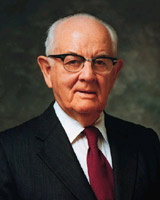|
Spencer Woolley Kimball, president of the Church of Jesus Christ of Latter-day Saints from 1973 to 1985, was born in Salt Lake City on 28 March 1895
to Andrew Kimball and Olive Woolley. His grandfathers were Heber C. Kimball and Edwin D. Woolley.
When Andrew Kimball was designated president of the St. Joseph Stake in 1898,
the Kimballs moved to Thatcher, Arizona. After a mission to the central
states and marrying Camilla Eyring, Spencer worked in banking, and later
insurance and real estate. He served as clerk, and then counselor in
the St. Joseph Stake presidency, and was president of the new Mount
Graham Stake from 1938 until his call as an apostle in 1943. He was
assigned in 1945 to work with American Indians, and he devoted great
effort to improving opportunities for Native Americans
through a program whereby thousands of Indian children lived with
Mormon families during the school year.
In December 1973 Kimball succeeded Harold B. Lee as president of the LDS Church. Though he was seventy-eight, he set a brisk pace. Despite his having suffered heart attacks in the 1940s, his energy was legendary and he exemplified his slogans, "Lengthen our stride" and "Do it." Throat cancer in the 1950s left him with a distinctive soft hoarse voice. He
encouraged missionary service by worthy young men and called for volunteers
among women and couples. He extended the church to communist countries
by avoiding political stances. Under his leadership
temples increased from sixteen to three times that many.
In June 1978 he announced a revelation that all worthy men and women could
receive temple ordinances regardless of race or ancestry, thus ending
long-standing restrictions on members of Negroid ancestry. The church under Kimball opposed the Equal Rights Amendment as a misguided means to reach legitimate objectives, and criticized the weapons buildup by
world powers, successfully opposing basing MX missiles in the Utah-Nevada desert.
Kimball directed the recreation of the First Quorum of Seventy, establishment
of emeritus status for general authorities, consolidation of church
meetings into a three-hour block, the publishing of new editions of
scriptures, and the creation of a museum and genealogy library.
This man short in stature had great energy, fierce loyalty, fearlessness
in innovation, unusual warmth, a lively sense of humor, and unshakable
faith. His wife, Camilla, also served many as role model. Highly intelligent
and independent, she nonetheless wholeheartedly supported him.
Brain surgery in 1979 slowed him, and recurring troubles in 1981 ended his
active leadership. During his last four years, his counselor Gordon B. Hinckley shouldered major responsibilities. President Kimball died 5 November 1985.
See:
Edward L. Kimball and Andrew E. Kimball, Jr., Spencer W. Kimball (1977);
Caroline E. Miner and Edward L. Kimball, Camilla (1980); and the Fall
1985 issue of BYU Studies.
|


